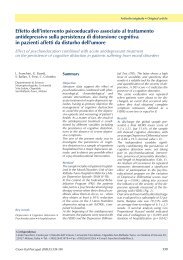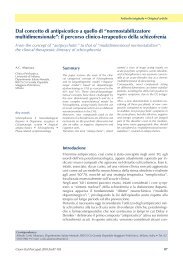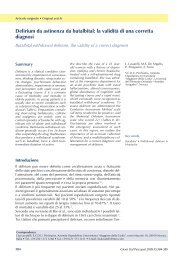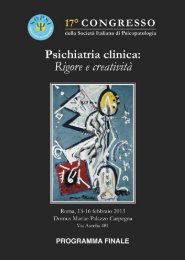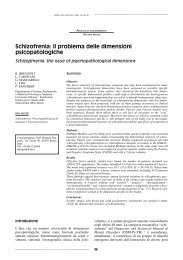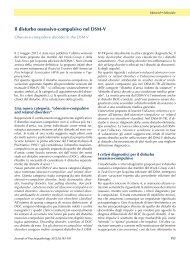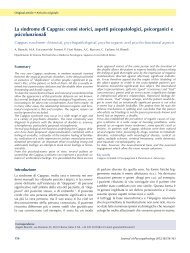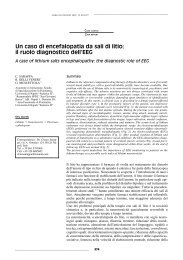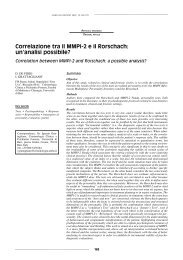Psychopatological severity index and dissociative symptomatology ...
Psychopatological severity index and dissociative symptomatology ...
Psychopatological severity index and dissociative symptomatology ...
You also want an ePaper? Increase the reach of your titles
YUMPU automatically turns print PDFs into web optimized ePapers that Google loves.
Original article<strong>Psychopatological</strong> <strong>severity</strong> <strong>index</strong> <strong>and</strong> <strong>dissociative</strong> <strong>symptomatology</strong>in a group of non-psychotic outpatientsIndici di gravità psicopatologica e sintomatologia dissociativa in una popolazione di pazientiambulatoriali non psicoticiF. Macrì, M. Salviati, A. Provenzano, C. Melcore, S. Terlizzi, S. Campi, M.M. Moscariello, M. BiondiDipartimento di Neurologia e Psichiatria, Unità di Psichiatria Psicofarmacologia Clinica, S.P.D.C. Policlinico “Umberto I”, Sapienza Universitàdi RomaSummaryDissociative symptoms are a set of symptoms frequently encounteredin clinical practice, but they are often underestimated bymany clinicians, who in the routine assessment of the patient underrateor not diagnose, emphasizing instead the importance ofmore classic <strong>and</strong> obvious symptoms, such as those related to thesphere of mood, anxiety or psychosis. In this way, <strong>dissociative</strong>symptoms often lose their descriptive complexity, although purelypsychopathological, of the very complex clinical status thatoften underlie <strong>dissociative</strong> symptoms <strong>and</strong> <strong>dissociative</strong> dynamics.For these reasons, this study assessed psychopathologicaldimensions of mood <strong>and</strong> anxiety disorders in a transnosographicway. The purpose of the study is to demonstrate that <strong>dissociative</strong>symptoms, although placed in the diagnostic category of <strong>dissociative</strong>disorders, have a common thread that correlates withthe main manifestations detected in routine clinical practice, <strong>and</strong>that they may be susceptible to intervention by the physician,even in a nonspecific way on the main symptom, not <strong>dissociative</strong>,that is treated.Key wordsDissociative disorders • Dissociation • Anxiety • Depression • Bipolardisorder • Obsessive-compulsive disorder • StressThe diagnosis of <strong>dissociative</strong> disorders, as a group of categoricalindependent nosographic entities, was first includedin the Diagnostic <strong>and</strong> Statistical Manual of MentalDisorders (DSM)-III in 1980; before that, <strong>dissociative</strong><strong>symptomatology</strong> was included among psychopathologicalphenomena ascribed to hysteria 1 . The essentialcharacteristic of <strong>dissociative</strong> disorders, according to theDSM‐IV-TR, is the disconnection of functions (physiologicallyintegrated), of consciousness, memory <strong>and</strong> perceptionof identity 2 . The term <strong>dissociative</strong> was introduced byJames in 1890 as a translation of the French term désagrégationcoined by Pierre Janet in 1889; with this term,the French author individuated the failure of mental integrationof ‘experiences’ (perceptions, memories, thoughts,emotions) that are normally concatenated with each otherin the flow of consciousness 1 . Dissociation leads to fragmentationof the unitary sense of self in patients whoexperience it, cancelling the unity of chronological, biographical<strong>and</strong> perceptual identity, which every individualnormally has 3 . In studies on hysteria (1893-1895), Freudelaborated a psychodynamic theory of dissociation (opposedto the psychopathological one of Janet, linked topassive ego deficits) based on active removal, in affectedsubjects, of traumatic material within a psychodynamicconflict. In both models, dissociation appears to be closelyrelated to the presence of a traumatic event 1 . Recentstudies have shown that the post-traumatic aetiologicalaspect of <strong>dissociative</strong> episodes identifies a part of <strong>dissociative</strong><strong>symptomatology</strong> (about 50%), but not the entire<strong>dissociative</strong> spectrum 4 . The <strong>dissociative</strong> spectrum (Fig. 1)is composed of a large continuum of <strong>dissociative</strong> <strong>symptomatology</strong>along a gradient of <strong>severity</strong> 1 .Such a spectrum even includes, according to some authors,somatoform disorders <strong>and</strong> can be divided into three groups:• non-clinical or subclinical <strong>dissociative</strong> experiences, suchas being so deeply assorbed in the contemplation of amovie or immersed in one’s own thoughts,that there is noawareness or realization of the surrounding environment(absorption);• transient <strong>dissociative</strong> phenomena in response to externalevents (trauma, induced states of trance);• clinically-relevant <strong>dissociative</strong> phenomena, either inassociation with other psychiatric disturbances (e.g.CorrespondenceFrancesco Macrì, Dipartimento di Neurologia e Psichiatria, Sapienza Università di Roma, Roma, Italia • E-mail: francesco.macri_md@libero.itJournal of Psychopathology 2013;19:105-108105
F. Macrì et al.Dissociative symptoms during other psychiatric disordersAbsorption Hypnotic Dissociative amnesia Dissociative identity<strong>and</strong> post-traumatic phenomena <strong>and</strong> <strong>dissociative</strong> fugue disorderTransient Depersonalization Somatizationdepersonalization disorder disorderPhysiologyHigher <strong>dissociative</strong> <strong>symptomatology</strong>FigURe 1.Continuum of <strong>dissociative</strong> <strong>symptomatology</strong> <strong>and</strong> related <strong>dissociative</strong> disorders. Continuum della sintomatologia dissociativa e relatividisturbi dissociativi.PTSD), or as a defined nosographic category (depersonalizationdisorder, <strong>dissociative</strong> amnesia, <strong>dissociative</strong>fugue, <strong>dissociative</strong> identity disorder <strong>and</strong> <strong>dissociative</strong>disorder not otherwise specified).According to some authors, the prevalence of <strong>dissociative</strong>disorders in clinical practice is underestimated,which may be in part due to the lack of inclusion of diagnosticcriteria for <strong>dissociative</strong> disorders in the algorithmof the Structured Clinical Interview for the diagnosis ofAxis I disorders in the DSM-IV (SCID-I), as well as thelack of large population-based studies 3 ; at present, theprevalence of <strong>dissociative</strong> disorders in the general populationis estimated to be from 5.6% to 10% 1 .At the same time, there is some evidence regarding theassociation of <strong>dissociative</strong> symptoms with some psychopathologicaldimensions, (in particular with obsessions 5 ,depression <strong>and</strong> anxiety 6 , psychotic symptoms 7 8 <strong>and</strong> withthe <strong>severity</strong> of a psychiatric disorders 5 ). Moreover, it hasbeen observed that patients affected with <strong>dissociative</strong>disorders have levels of psychopathology (assessed withSCL90-R) that are significantly greater than those in psychiatricpatients who are non-dissociators 10 . Consideringthis, the aim of the present study was to investigate therelation between <strong>dissociative</strong> <strong>symptomatology</strong>, psychopathologicaldimensions (assessed with SCL90-R) <strong>and</strong>clinical <strong>severity</strong> in an out-patient population.Materials <strong>and</strong> methodsOver an 18-month period, a total of 83 patients (of 213contacted) were recruited among those presenting to theout-patient psychopharmacological clinic at PoliclinicoUmberto I, during the first visit. Inclusion criteria included:diagnosis of anxiety, mood <strong>and</strong> somatoform disorder <strong>and</strong>adaptation; score > 17 on at least one of the Hamiltonscales (A or D). Exclusion criteria were: psychotic disorder,illiteracy, unable to underst<strong>and</strong> questionnaires, presenceof a neurodegenerative disease, concomitant diagnosis ofepilepsy or on-going problem with addiction.The study protocol included the administration of aquestionnaire for personal data, authorization to keepsensitive data, evaluation scales completed by a clinician(Clinical Global Impression [CGI], Hamilton AnxietyRating Scale [HAM-A], Hamilton Depression RatingScale [HAM-D]); self-evaluation questionnaires relativeto general psychiatric symptoms (Symptom Checklist-90-Revised-SCL90-R) <strong>and</strong> <strong>dissociative</strong> <strong>symptomatology</strong>(Dissociative Experiences Scale [DES]).The CGI evaluates general clinical <strong>severity</strong> of the patientusing a scale from 0 to 7 (0 = Not assessed 1 = Normal,not at all ill, 2 = Borderline mentally ill, 3 = Mildlyill, 4 = Moderately ill, 5 = Markedly ill, 6 = Severely ill,7 = Among the most extremely ill patients); the two Hamiltonscales evaluate anxiety symptoms (score ≥18 consideredpathological) <strong>and</strong> depression (score ≥ 25 = severedepression; 18-24 = moderate depression; 8-17 = slightdepression; ≤ 7 absence of depression).The SCL 90-R assesses 9 psychopathological dimensions(somatization, obsession-compulsion, interpersonal sensitivity,depression, anxiety, anger-hostility, phobic anxiety,paranoid ideation, psychoticism), <strong>and</strong> on the basis of thetotal score considering 90 items, the Global Severity Index(GSI) can be calculated; a value greater than 0.566 is con-106
<strong>Psychopatological</strong> <strong>severity</strong> <strong>index</strong> <strong>and</strong> <strong>dissociative</strong> <strong>symptomatology</strong> in a group of non-psychotic outpatientssidered indicative of clinically-relevant psychopathology.Using the DES, <strong>dissociative</strong> <strong>symptomatology</strong> was evaluateddimensionally <strong>and</strong> transnosographically. The DES isa self-rating scale that measures the level <strong>and</strong> type of <strong>dissociative</strong>experience present (the period of evaluation islifelong, in general) without considering the diagnosis; itis quick to compile <strong>and</strong> is composed of 30 questions thatconsider a score from 0 to 100 in intervals of 10; overallmean global scores higher than 20 are indicative for thepresence of a <strong>dissociative</strong> disturbance 9 . Through a diagnosticinterview, for each patient, a diagnosis was formulatedbased on the criteria in the DSM IV-TR 2 .The SPSS 13 programme was used for statistical analysis,<strong>and</strong> the distribution of variance was analyzed usingthe Kolmogorov-Smirnov test. Based on the results of thequantitative distribution of variables (e.g. CGI <strong>and</strong> age didnot have a normal distribution), non-parametric statisticalanalyses were carried out. Correlations between quantitativevariables were evaluated with Spearman’s rho test.A p < 0.05 was considered statistically significant.ResultsThe sample population was recruited over a period of18 months. A total of 83 patients were included, with amean age of 46.75 (± 15.33) years (range 17-82); therewere 51 females <strong>and</strong> 32 males. The presence of disordersaccording to DSM-IV TR criteria, are shown in Table 1.Mood <strong>and</strong> anxiety disorders were present in similar proportions(42.17% <strong>and</strong> 38.55%, respectively).From a descriptive analysis of the psychometric parametersevaluated (Table II), the sample cohort had intermediatelevels of dissociation from normal (DES 17) <strong>and</strong> moderateglobal clinical levels of disease (mean CGI = 4); thelevel of psychopathology as revealed by the self-administeredSCL90-R (GSI) test was clinically significant(GSI > 0.566).The psychopathological dimension of the SCL90-R mostfrequently seen was depression, obsessive-compulsive,anxiety, somatization, paranoid ideation <strong>and</strong> interpersonalsensitivity. The indices of psychopathological <strong>severity</strong>from the GSI <strong>and</strong> CGI were significantly correlatedwith the <strong>severity</strong> of <strong>dissociative</strong> symptomology (DES).Each psychopathological dimension investigated usingthe SCL90-R test showed a significant correlation withthe <strong>dissociative</strong> symptomology score (p < 0.001). TheHamilton scales did not show any significant correlationwith the <strong>severity</strong> of dissociation.ConclusionsThe aim of the present study was to investigate corre-TabLe I.Stratification of the sample according to diagnosticarea. Stratificazione del campione in funzione delle areediagnostiche DSM IV-TR.Diagnostic area N %Anxiety disorders 32 38.55Mood disorders (monopolar) 18 21.69Mood disorders (bipolar) 17 20.48Adaptive disorders 11 13.25Somatoform disorders 5 6.03lations between <strong>severity</strong> of psychopathological manifestations<strong>and</strong> <strong>dissociative</strong> symptomology. Our resultsshowed that the intensity of <strong>dissociative</strong> symptoms appearedto be directly proportional to the <strong>severity</strong> of thepsychopathological dimensions considering both theGSI <strong>and</strong> CGI. In addition, the <strong>severity</strong> of dissociationseems to be correlated with <strong>severity</strong> of each psychopathologicaldimension assessed with the SCL90-R. Previousstudies have shown a relationship between somepsychopathological dimensions <strong>and</strong> <strong>dissociative</strong> symptomologyin patients grouped by the type of disorder 5-8 .It has also been demonstrated that in patients with <strong>dissociative</strong>disorders the psychopathological dimension ofthe SCL90-R was significantly higher compared to psychiatricpatients that were not affected by <strong>dissociative</strong>disorders 10 . The data from our patient cohort allowedfor the individuation, in a transnosographic manner, of aclose relation between psychopathological <strong>severity</strong> <strong>and</strong>the level of dissociation. From a clinical st<strong>and</strong>point, inour opinion, these results should prompt considerationsregarding the relevance of <strong>dissociative</strong> symptomologyduring a psychiatric visit as a tool for future integrated<strong>and</strong> personalized approaches to treatment. Consideringpsychological disturbances in a hodological context, oras the manifestations of functional disconnection betweendifferent brain areas, as suggested by Ffytche 11 ,the results of our study are suggestive of the possibilitythat the <strong>dissociative</strong> symptomology represents a quantitativemanifestation of alterations in cerebral circuits;at the same time, the psychopathological dimensionswould qualitatively identify areas that are disconnected.Such a hodological vision of psychopathology, lastly,brings us back to the definition of <strong>dissociative</strong> disordersas a manifestation of désagrégation of brain functionoriginally described by Janet. Further studies on largerpatient series, using neuroimaging techniques, instrumentsto assess neurophysiopathological function <strong>and</strong>mental tests, are needed to evaluate the reliability of ourresults <strong>and</strong> their interpretation.107
F. Macrì et al.TabLe II.Descriptive statistics <strong>and</strong> correlations. Statistica descrittiva e correlazioni.Descriptive StatisticsStatistical correlationParameter Mean SD Correlation coefficientSpearman’s rho testSig(2 code)DES 13.800 14.900 1.000 –Ham-A 18.870 4.420 - 0.075 0.533Ham-D 16.980 4.670 0.117 0.326CGI 4.000 0.563 0.233 0.049GSI 1.286 0.687 0.757 0.000Somatization 1.302 0.787 0.497 0.000Obsessive/compulsivity 1.575 0.949 0.677 0.000Interpersonal sensitivity 1.172 0.871 0.716 0.000Depression 1.703 0.878 0.603 0.000Anxiety 1.514 0.809 0.540 0.000Anger/hostility 0.873 0.802 0.655 0.000Phobic anxiety 0.775 0.920 0.396 0.000Paranoid ideation 1.196 0.964 0.616 0.000Psychoticism 0.892 0.761 0.725 0.000References1Dell PF, O’Neil JA, editors. Dissociation <strong>and</strong> the <strong>dissociative</strong>disorders: DSM-V <strong>and</strong> beyond. New York: Routledge 2009.2American Psychiatric Association. DSM-IV-TR. Manuale Diagnosticoe Statistico dei disturbi mentali. Milano: Masson 2001.3Steinberg M, Schnall M. La dissociazione. Cinque sintomifondamentali. Milano: Raffaello Cortina Editore 2006.4Isaac M, Ch<strong>and</strong> PK. Dissociative <strong>and</strong> conversion disorders:defining boundaries. Curr Opin Psychiatry 2006;19:61-6.5Belli H, Ural C, Vardar MK, et al. Dissociative symptoms <strong>and</strong><strong>dissociative</strong> disorder comorbidity in patients with obsessivecompulsivedisorder. Compr Psychiatry 2012;53:975-80.6Moscariello MM, Ratti F, Quartini A, et al. [Dissociativesymptoms in patients with mood <strong>and</strong> anxiety disorders]. RivPsichiatr 2010;45:234-43.7Perona-Garcelán S, Cuevas-Yust C, García-Montes JM, etal. Relationship between self-focused attention <strong>and</strong> dissociationin patients with <strong>and</strong> without auditory hallucinations.J Nerv Ment Dis 2008;196:190-7.8Modestin J, Hermann S, Endrass J. Schizoidia in schizophreniaspectrum <strong>and</strong> personality disorders: role of dissociation.Psychiatry Res 2007;153:111-8.9Conti, L. Repertorio delle scale di valutazione in psichiatria.Firenze: SEE Editrice 2002.10Steinberg M, Barry DT, Sholomskas D, et al. SCL-90 symptompatterns: indicators of <strong>dissociative</strong> disorders. Bull MenningerClin 2005.;69:237-49.11Ffytche DH. The hodology of hallucinations. Cortex2008;44:1067-83.108




